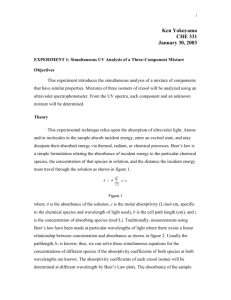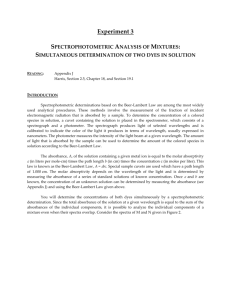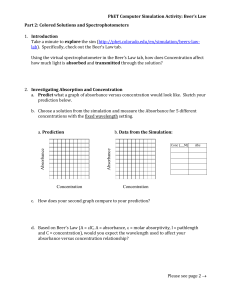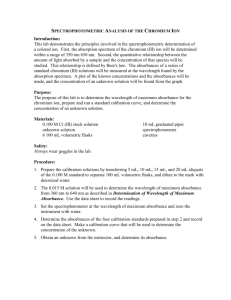CHE331.UV-CresolIsomers
advertisement
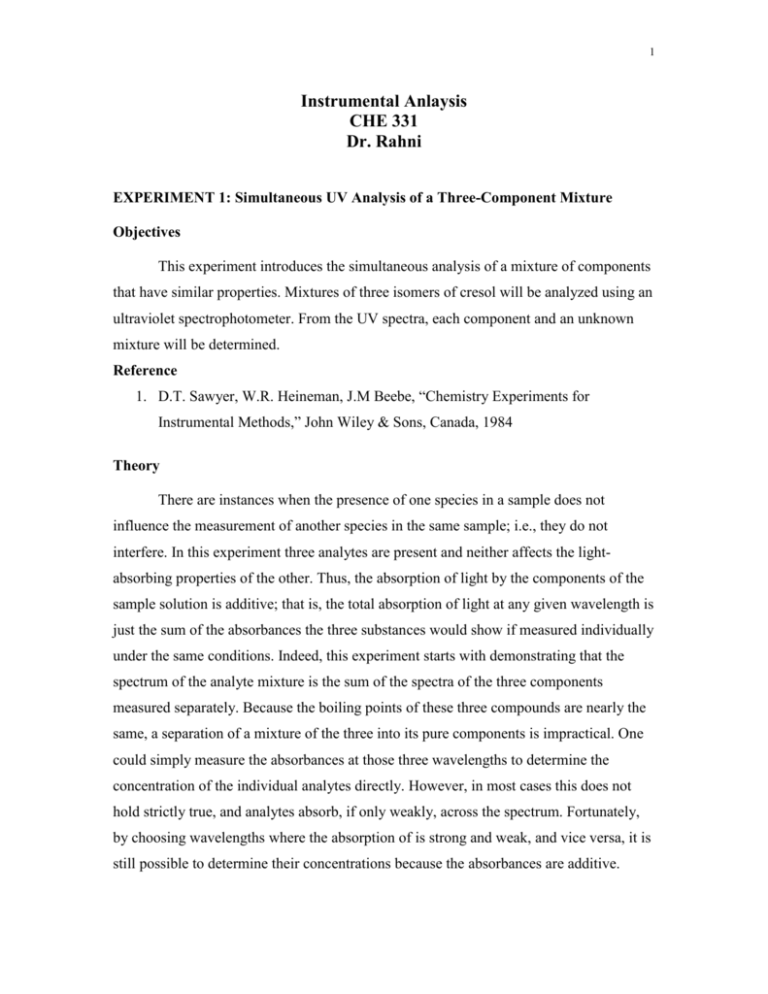
1 Instrumental Anlaysis CHE 331 Dr. Rahni EXPERIMENT 1: Simultaneous UV Analysis of a Three-Component Mixture Objectives This experiment introduces the simultaneous analysis of a mixture of components that have similar properties. Mixtures of three isomers of cresol will be analyzed using an ultraviolet spectrophotometer. From the UV spectra, each component and an unknown mixture will be determined. Reference 1. D.T. Sawyer, W.R. Heineman, J.M Beebe, “Chemistry Experiments for Instrumental Methods,” John Wiley & Sons, Canada, 1984 Theory There are instances when the presence of one species in a sample does not influence the measurement of another species in the same sample; i.e., they do not interfere. In this experiment three analytes are present and neither affects the lightabsorbing properties of the other. Thus, the absorption of light by the components of the sample solution is additive; that is, the total absorption of light at any given wavelength is just the sum of the absorbances the three substances would show if measured individually under the same conditions. Indeed, this experiment starts with demonstrating that the spectrum of the analyte mixture is the sum of the spectra of the three components measured separately. Because the boiling points of these three compounds are nearly the same, a separation of a mixture of the three into its pure components is impractical. One could simply measure the absorbances at those three wavelengths to determine the concentration of the individual analytes directly. However, in most cases this does not hold strictly true, and analytes absorb, if only weakly, across the spectrum. Fortunately, by choosing wavelengths where the absorption of is strong and weak, and vice versa, it is still possible to determine their concentrations because the absorbances are additive. 2 This experimental technique relies upon the absorption of ultraviolet light. Atoms and/or molecules in the sample absorb incident energy, enter an excited state, and may dissipate their absorbed energy via thermal, radiant, or chemical processes. Beer’s law is a simple formulation relating the absorbance of incident energy to the particular chemical species, the concentration of that species in solution, and the distance the incident energy must travel through the solution as shown in figure 1. Figure 1 where A is the absorbance of the solution, ε is the molar absorptivity (L/molcm, specific to the chemical species and wavelength of light used), b is the cell path length (cm), and c is the concentration of absorbing species (mol/L). Traditionally, measurements using Beer’s law have been made at particular wavelengths of light where there exists a linear relationship between concentration and absorbance as shown in figure 2. Usually the pathlength, b, is known; thus, we can solve these simultaneous equations for the concentrations of different species if the absorptivity coefficients of both species at both wavelengths are known. The absorptivity coefficients of each cresol isomer will be determined at different wavelength by Beer’s Law plots. The absorbance of the sample mixture will then be obtained for the same wavelengths; solution of simultaneous equations will thus enable us to Figure 2 obtain estimates of the cresol concentrations. Beer’s law is valid simultaneously for all absorbers in a solution. Let’s imagine that we have three analyte species, a, b, and c, present in a solution. The absorbance due to the three individual species will usually add to give the total absorbance of the solution. The absorbance at any wavelength is due to the absorbance of each species: 3 Absorbance at wavelength λ= abs. by species a + abs. by species b + abs. by species c Beer’s Law applies to each absorbing species independently; thus, we may express the absorbance at any wavelength as Abs aAbC A aBbCB aC bCC where A is the absorptivity of species a at wavelength λ. This additive property of absorbance can determine the concentrations of both components of a mixture by measuring the absorbance at three different wavelengths within the range of the scan. The absorbance of “unknown” sample(s) at three different wavelengths; the concentration of the three analytes, a, b and c, are determined by solving the following equations: A1 k1a [a ] k1b [b] k1c [c] A2 k2a [a ] k2b [b] k2c [c] A3 k3a [a ] k3b [b] k3c [c] Where A1 , A2 , and A3 are the three absorbance measurements at λ1 ,λ2 , and λ3 respectively. The k values, the products of absorptivity and pathlength, must be determined by separate calibration (i.e., Beer’s Law plots). From these equations, [a], [b], and [c] in terms of the k's, and A1 , A2 , and A3 and can be solved for the concentrations. Ortho-cresol, meta- cresol, and para- cresol are structural isomers. The names of the three compounds indicate which of the hydrogens on the benzene ring portion of the molecule have been replaced. They are obtained from coal tar or petroleum. The mixture of cresols obtained from coal tar is called cresylic acid, an important technical product used as a disinfectant and in the manufacture of resins and tricresyl phosphate. Cresols are useful as raw materials for various chemical products, disinfectants and synthetic resins. The isomer o-cresol is a starting material for the herbicides 4,6-dinitro-o-cresol (DNOC) and 2-methyl-4-chlorophenoxyacetic acid (MCPA). The isomers m-cresol and p-cresol are used in phenol-formaldehyde resins and are converted to tricresyl phosphate (a plasticizer and gasoline additive) and to di-tert-butylcresols (antioxidants called BHT). 4 o-cresol m-cresol p-cresol Materials / Chemicals Required Chemicals Diluted stock solutions of o-, m-, p-cresol will be provided. Their exact concentrations will be provided by the instructor. Instrument and Equipment Instrumentation This experiment will be conducted using a Perkin Elmer lambda 2 UV-Visible Spectrophotometer. The instrument has a wavelength range of 190-1100 nm with a resolution of 2 nm. The optical system (shown below) consists of two lamps, arranged so that the emission from the tungsten lamp shines through the deuterium lamp. The lamps emit light at 190-800 nm and 370-1100 nm, respectively. Procedure I. First, determine the suitable wavelengths for the analysis by obtaining an absorption spectrum for m-cresol, p-cresol, and o-cresol separately. A. Prepare the following solutions: 1. Pipet 5, 10, 15 and 20 mL of the 0.05 g/L stock solution of p-cresol into a 25-mL volumetric flask and diluting to the mark. Mix well. 2. Repeat for m-cresol and o-cresol. 3. Follow the SOP for operation of the UVspectrophotometer. 4. Obtain the spectra for both solutions from 240 nm to 300 nm (or as narrow a range as possible). 5. Generate a Beer's Law (A vs. C) for all species II. Next, prepare mixtures of the following solutions: 5 Mixtures #1 p-15 #2 m-15 #3 o-15 III. o-cresol 5 ml 5 ml 15 ml m-cresol 5 ml 15 ml 5 ml p-cresol 15 ml 5 ml 5 ml Finally, obtain unknown(s) from the instructor. This solution contains a mixture of the cresol isomers. Obtain its absorption spectrum, recording the absorbance at the wavelengths of interest.
